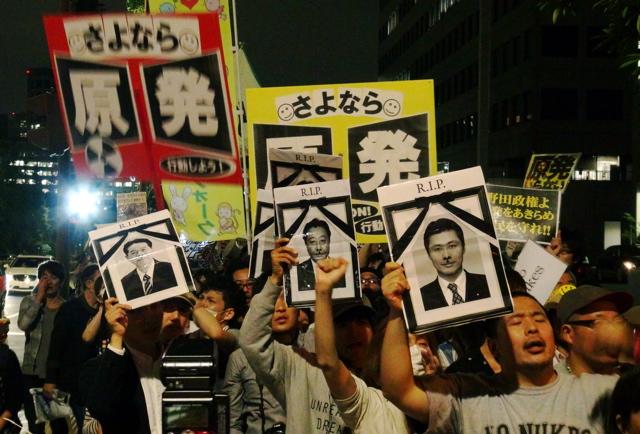
As
the government hastily moved towards the restart of operation of Oi Nuclear
Power Plant, many protest actions were organized across the country by citizens
during the first half of June.
In
Tokyo, 2700 people gathered in front of the Prime Minister's Official Residence
on June 1 for the Friday evening demonstration. The number of participants in
this weekly action that several anti-nuke groups in the Metropolitan area
started in March grew rapidly as the information spread through Twitter and
other means on internet.
On
June 8, an estimated 4000 protesters listened to the radio broadcast of the
announcement by Prime Minister NODA Yoshihiko to restart two idled reactors of
Oi Nuclear Power Plant live through amplifiers prepared by action organizers.
Outraged, they started shouting before the announcement was over. As it
finished, the cries turned into a roar of "No to restart!"in unison and
lasted for half an hour.
The
number of participants of the following week, 15 June, was well above 10,000.
The sidewalk along the subway exits was soon filled
with people all the way down from the corner facing to the Prime Minister's
Office. The police ultimately made part of the road available for the
protesters.
As
the media reported that the government would make the decision on 16 June, people
were were with anger. "Nuclear plants are too dangerous. Operation should
never be resumed." "Save the children!" "People's lives are
more important than the economy." "The process so far is not at all
democratic." Many ordinary citizens, including young men and women, office
workers, housewives and students took the microphone and expressed their
opinions. So did some no-nukes activists/entertainers and Diet members
including those from the ruling Democratic Party.
The
media coverage of these protests was limited. Though there were more than 100
reporters on the site on June 15, no reports were aired on TV or radio news
programmes that night. Among major newspapers available in the Tokyo
Metropolitan area, only one national daily had an article without a photo the
following morning. People opposing to the restart were increasingly frustrated
with mass media.
In
the vicinity of the Prime Minister's Official Residence, various groups
conducted protest actions on other days as well. (See another article on the
die-in by women from Fukushima) .
On June 14, OE Kenzabro, a Nobel laureate writer, and other representatives
of the No Nukes 10 Million Signatures Campaign met with Chief Cabinet Secretary FUJIMOTO Osamu in the Prime
Minister's Official Residence to submit
7,222,297 signatures collected by the beginning of June. The rally and
march for the first interim report of the
Campaign was
held on June 6 in Hibiya Koen Park in the central business and administrative
area with some 2300 participants.
Photos of June 15 action with reportsin Japanese; Photos of June 15 action (by NISHINAKA Seiichiro); YouTube Video(June 15, 3 min.); Reutors Report on June155
「危険な原発やめてくれ!」官邸前で怒り爆発!~1万人こえる人々が結集
政府が大飯原発再稼動への動きを進めた6月前半、日本各地で市民による抗議行動が活発化するなか、東京では、首都圏の市民団体がツイッターなどで呼びかけ、3月から続いている、金曜夕方の首相官邸前抗議行動に参加する人の数が急激に増えた。
6月1日には2700人、野田首相による「再稼働宣言」が行われた8日には、4000人が集まり、記者会見のラジオ中継を、スピーカーを通して聞いた。首相の発言が終わる前から多くの怒号があがり、発言終了後は直ちに「再稼動反対!」のコールが沸き起こった。
15日の参加者はついに1万人を超えた。官邸前からメトロ沿いの歩道はぎっしり埋まり、警官隊もついに車道の一部を開放して、人並みの整理にあたった。「16日にも最終決定」と報道され るなか、人々の怒りはピークに達していた。「とにかく危険な原発を絶対にやめてくれ」「子どもを守りたい」「経済より命」「日本は民主主義国ではないの
か」「なぜマスコミは反対の声を報道しないのか」オープンマイクで若者・サラリーマン・女性・主婦・学生が次々に訴えた。山本太郎、藤波心、民主党や共産 党の国会議員もマイクを握った。
大手メディアによる このような抗議行動の報道は、極めて限られていた。15日夜の首相官邸前には100名を越える取材陣が集まったが、TV/ラジオでは全くとりあげられず、翌日の新聞は全国紙一社が写真もない小さな記事を載せたのみ。市民は大手メディアへも怒りを募らせている。
官邸周辺では、他の日にも、福島の女性たちによるダイイン(別の記事を参照)など、連日なんらかの抗議行動が続けられた。また、6日には、日比谷公園で「さようなら原発1000万人署名・第一次集約集会」が開かれ、2300人の参加者が、デモ行進を行なった。集められた722万2297人の署名は、14日にノーベル賞受賞者大江健三郎氏らの呼びかけ人が、首相官邸で藤村官房長官に提出した。
No comments:
Post a Comment